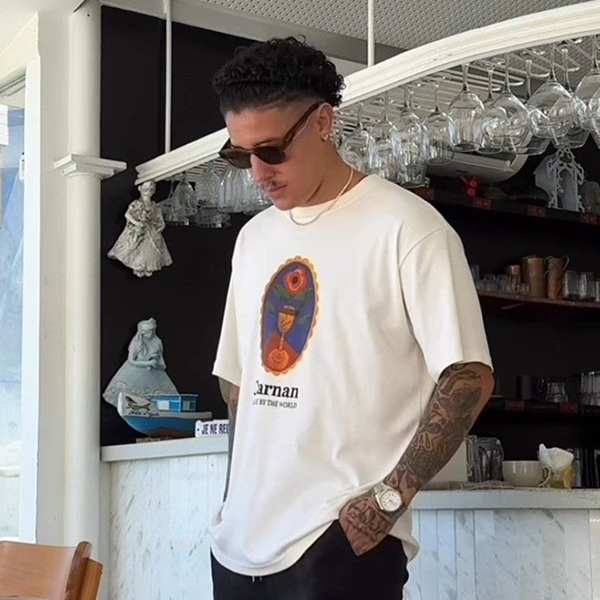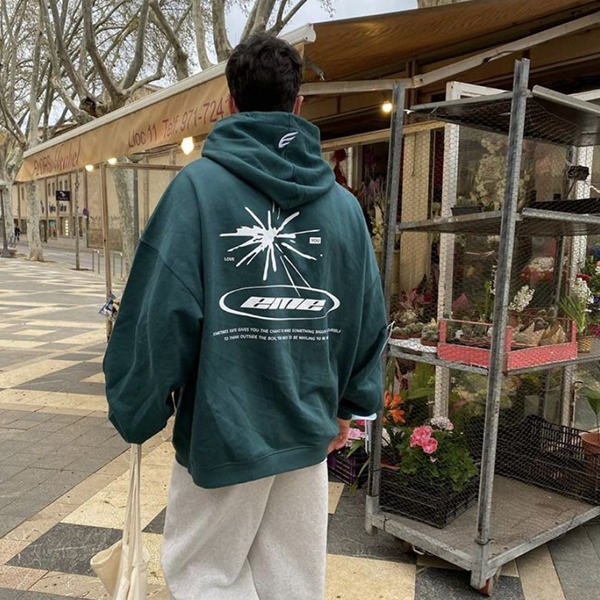The T-shirt — perhaps the simplest, most universal garment known to humanity — has transcended its humble beginnings to become the very foundation of modern style. Once just a utilitarian piece of cloth meant to keep soldiers comfortable beneath their uniforms, it has evolved into a cultural symbol, a blank canvas, and an extension of identity.
In 2025, as fashion continues to navigate a world defined by contradictions — fast yet mindful, digital yet tactile — the T-shirt remains steadfast. It’s still the first item people pack, the first thing they reach for in the morning, the one garment that bridges generations, cultures, and classes. But make no mistake: today’s T-shirt isn’t just a basic. It’s a philosophy.
1. The Quiet Revolution of the Everyday
The power of the T-shirt lies in its silence.
No seams screaming for attention, no embellishments demanding validation — just a clean silhouette, a soft touch, and a sense of ease.
It is, in essence, anti-fashion fashion.
While luxury brands chase opulence and social media amplifies excess, the T-shirt quietly endures. It represents everything modern consumers are yearning for: honesty, comfort, and authenticity.
That’s the irony of our times — the garment that once lived beneath everything else now sits on top of the fashion hierarchy.
When you see someone in a crisp white tee, perfectly fitted, you’re not just seeing fabric; you’re seeing a declaration: I don’t need to try too hard to look good.
2. From Undergarment to Icon
Let’s rewind.
The T-shirt’s story begins in the early 1900s with the U.S. Navy, where sailors wore lightweight cotton undershirts to stay cool during long, grueling shifts. These undershirts — cheap, durable, and easy to wash — soon caught on among workers, miners, and laborers.
Then came the Hollywood revolution.
Marlon Brando, James Dean, and later, Paul Newman — men who embodied rebellion, sensitivity, and strength — wore T-shirts not as underwear, but as statements.
The look was raw, sensual, and unapologetically masculine.
By the time the 1960s arrived, the T-shirt had gone political. Protesters wore them emblazoned with anti-war slogans. Artists used them to challenge authority. The T-shirt became the first truly democratic medium of fashion communication — accessible to all, yet personal to each wearer.
And as the decades rolled on, it adapted effortlessly: punk graphics in the 1970s, oversized hip-hop tees in the ‘90s, minimalist designer versions in the 2010s, and the sustainability-focused basics of the 2020s.
Every era had its T-shirt moment.
3. The Anatomy of Perfection
At first glance, it seems easy to make a T-shirt.
But achieving a perfect one is a pursuit of precision. Every element — the fabric weight, the shoulder seam, the collar binding, the hemline length — contributes to a subtle architecture of comfort and proportion.
A great T-shirt feels invisible when you wear it.
It drapes naturally, follows your movement, and rests softly against the skin.
The modern brands leading this quiet revolution — including Trendytroop and other minimalist houses — treat the T-shirt not as a commodity, but as an art form.
They experiment with organic cottons, bamboo blends, and sustainable modal fabrics to create tees that are breathable, durable, and kind to the planet.
Fit has become an expression in itself:
- Slim fits emphasize structure and sharpness.
- Boxy cuts echo streetwear aesthetics.
- Heavyweight tees nod to vintage workwear.
- Relaxed silhouettes speak to mindfulness and ease.
Each variation tells a story about who you are and how you live.
4. The Emotional Weight of Simplicity
There’s a psychological dimension to wearing a T-shirt that people often overlook.
It’s a garment that removes pretense.
When you strip away layers — both literal and metaphorical — you reveal something honest. That’s what a T-shirt does: it leaves you bare, but in control.
That’s why stylists often describe the “perfect white tee” as the ultimate confidence test. You can’t hide behind it; it either works or it doesn’t.
Yet, when it does, it becomes transformative.
The right T-shirt doesn’t just flatter your frame — it calibrates your energy. It makes you feel grounded, real, and quietly powerful.
That’s what makes it timeless.
5. Minimalism as a Form of Luxury
In the early 2020s, fashion experienced what could be called the quiet luxury renaissance.
Logos faded. Shouting gave way to whispering.
People began craving subtlety — well-made, perfectly proportioned essentials that spoke to discernment, not ego. The T-shirt naturally became the centerpiece of that movement.
Luxury now means owning less, but owning right.
Consumers no longer want 20 cheap tees. They want three perfect ones that age gracefully, feel better with time, and carry a conscience.
Brands like The Row, Sunspel, and Fear of God have embraced this philosophy, but the sentiment extends beyond the high-end market. Even streetwear and indie labels now prioritize durability, ethical production, and tactile satisfaction over hype.
In other words, simplicity is no longer a compromise — it’s an aspiration.
6. The T-Shirt as Identity
Every generation redefines what the T-shirt means to them.
For Gen X, it was rebellion. For Millennials, it was minimalism. For Gen Z, it’s individuality.
Today, the T-shirt is both personal and political.
It can say everything about your worldview — or nothing at all. It can carry the logo of your favorite artist, or it can be plain black and still make a statement.
But more than ever, people are choosing subtle identity over overt branding. A blank tee, worn with confidence, says, “I don’t need symbols to be seen.”
It’s no coincidence that the world’s most influential creatives — designers, photographers, tech founders, musicians — gravitate toward neutral tees. It’s their way of focusing attention on what matters most: the work, the art, the expression.
7. Sustainability: The Fabric of the Future
We can’t talk about fashion in 2025 without talking about responsibility.
Every T-shirt made has an impact — from water usage to labor ethics to post-consumer waste. And the new generation of shoppers is acutely aware of it.
This has pushed a wave of innovation:
- Organic cotton farming that conserves soil health.
- Closed-loop production systems that recycle old garments.
- Natural dye processes that eliminate toxic runoff.
- Traceability technologies that let consumers know exactly where their clothes come from.
The T-shirt, once a symbol of consumption, has become the testing ground for sustainable innovation.
It’s poetic, really — the simplest garment leading the most important revolution.
8. The Future: Function Meets Philosophy
What’s next for the T-shirt?
The answer isn’t louder graphics or bolder colors — it’s smarter design.
Imagine self-cooling fabrics that adjust to your body temperature. Tees that resist odor without harmful chemicals. Digital tags that verify ethical sourcing.
But beyond the tech, the T-shirt’s evolution will be about mindset.
The new generation doesn’t separate fashion from life. The T-shirt embodies that union — comfort meeting consciousness.
In a future where digital avatars and physical presence blend, the T-shirt will remain the one piece that feels real — the thing that connects skin, soul, and story.
9. The Philosophy of Ease
The beauty of a T-shirt lies in its democratic spirit.
It doesn’t discriminate. It belongs to everyone — regardless of status, culture, or creed.
When you wear a T-shirt, you’re joining a global community built on simplicity.
And yet, within that simplicity, there’s infinite possibility: the cut, the texture, the color, the way it falls on your body — all tell a unique story.
That’s what makes it eternal.
Fashion will continue to evolve, but the T-shirt will always be its foundation — not because it’s trendy, but because it’s true.



